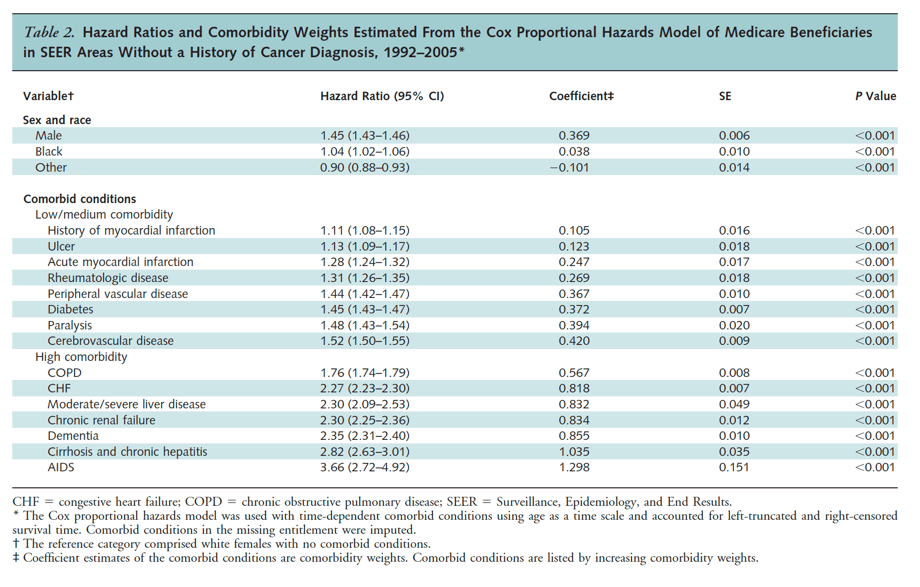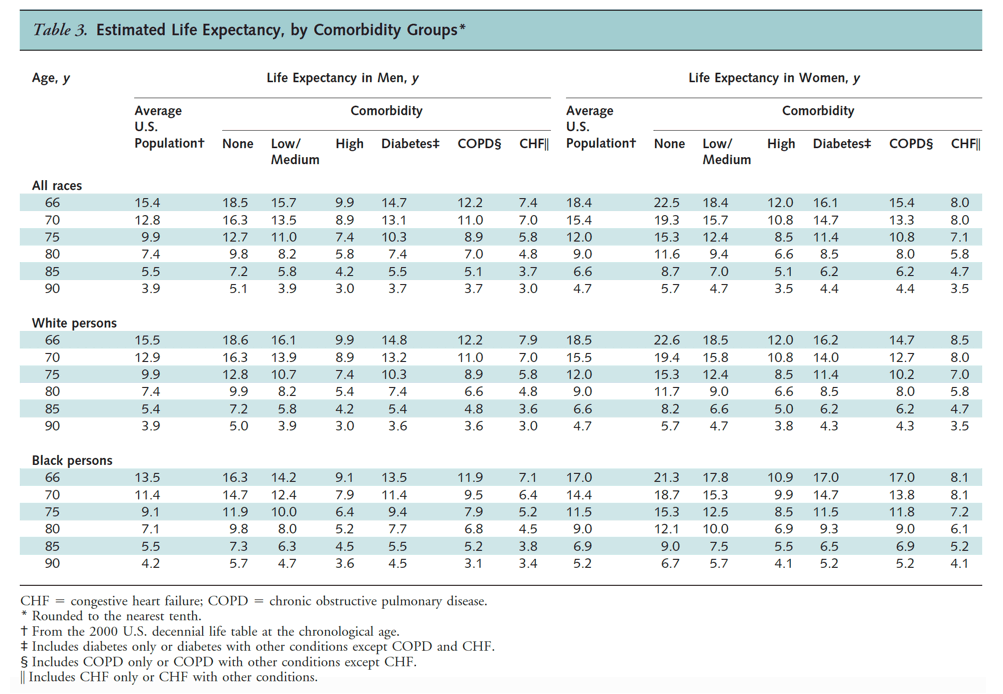| |
Life Expectancy Decreases with Comorbidities -
Comorbidity-Adjusted Life Expectancy: A New Tool to
Inform Recommendations for Optimal Screening Strategies
|
| |
| |
Download the PDF here
".......The life expectancy of persons with CHF was shorter and that of persons with COPD was shorter or similar (for example, black women) compared with that of the average U.S. population of the same chronological age (Table 3). For example, the life expectancy of a white woman at age 75 years with CHF was 5 years less than that of the average U.S. white woman. When compared with a white woman with no comorbid conditions at age 75 years, the life expectancy for women with diabetes, COPD, and CHF was about 4, 5, and 8 years shorter....Of all comorbid conditions examined, AIDS was associated with the highest risk for death (hazard ratio, 3.66 [95% CI, 2.72 to 4.92]). Persons with diabetes, COPD, and CHF had, respectively, at least a 1.45, 1.76, and 2.27 times greater hazard of dying compared with those with no comorbidity."
Annals 2013
In this study, we estimated life expectancies for elderly persons without a history of cancer, taking into account their comorbid conditions. We found substantial variation between estimated life expectancies for healthy persons without comorbidity and those with high levels of comorbidity or specific conditions, such as diabetes, CHF, and COPD. Those with higher levels of comorbidity had shorter life expectancies relative to an average person of the same chronological age. Persons with no comorbid conditions, even in their 80s, had longer life expectancies relative to an average person of the same age.
The Effect of Comorbid Conditions on the Risk for Death
Of all comorbid conditions examined, AIDS was associated with the highest risk for death (hazard ratio, 3.66 [95% CI, 2.72 to 4.92]). Persons with diabetes, COPD, and CHF had, respectively, at least a 1.45, 1.76, and 2.27 times greater hazard of dying compared with those with no comorbidity. The hazard of death for persons in the high comorbidity group was at least 1.76 times greater than that of persons in the no-comorbidity group (Table 2).
Background:
Many guidelines recommend considering health status and life expectancy when making cancer screening decisions for elderly persons.
Objective:
To estimate life expectancy for elderly persons without a history of cancer, taking into account comorbid conditions.
Design:
Population-based cohort study.
Setting:
A 5% sample of Medicare beneficiaries in selected geographic areas, including their claims and vital status information.
Participants:
Medicare beneficiaries aged 66 years or older between 1992 and 2005 without a history of cancer (n = 407 749).
Measurements:
Medicare claims were used to identify comorbid conditions included in the Charlson index. Survival probabilities were estimated by comorbidity group (no, low/medium, and high) and for the 3 most prevalent conditions (diabetes, chronic obstructive pulmonary disease, and congestive heart failure) by using the Cox proportional hazards model.
Comorbidity-adjusted life expectancy was calculated based on comparisons of survival models with U.S. life tables. Survival probabilities from the U.S. life tables providing the most similar survival experience to the cohort of interest were used.
Results:
Persons with higher levels of comorbidity had shorter life expectancies, whereas those with no comorbid conditions, including very elderly persons, had favorable life expectancies relative to an average person of the same chronological age. The estimated life expectancy at age 75 years was approximately 3 years longer for persons with no comorbid conditions and approximately 3 years shorter for those with high comorbidity relative to the average U.S. population.
Limitations:
The cohort was limited to Medicare fee-for-service beneficiaries aged 66 years or older living in selected geographic areas. Data from the Surveillance, Epidemiology, and End Results cancer registry and Medicare claims lack information on functional status and severity of comorbidity, which might influence life expectancy in elderly persons.
Conclusion:
Life expectancy varies considerably by comorbidity status in elderly persons. Comorbidity-adjusted life expectancy may help physicians tailor recommendations for stopping or continuing cancer screening for individual patients.

Life Expectancy by Comorbidity
Estimated life expectancies were longer for persons in the no-comorbidity group, shorter for the high group, and similar for the low/medium group when compared with life expectancies in the U.S. life table matched by age, race, and sex (Table 3). Relative to the life expectancy of the average U.S. population, the estimated life expectancy for persons aged 75 years with no comorbidity was approximately 3 years longer, but for persons with high comorbidity, it was approximately 3 years shorter. As age increases, the effect of comorbidity on life expectancy decreases. For example, compared with the life expectancies of the average U.S. white male population, the life expectancy of a white man in the high comorbidity group was about 6 years shorter at age 66 and 1 year shorter at age 90.
The life expectancy of persons with CHF was shorter and that of persons with COPD was shorter or similar (for example, black women) compared with that of the average U.S. population of the same chronological age (Table 3). For example, the life expectancy of a white woman at age 75 years with CHF was 5 years less than that of the average U.S. white woman. When compared with a white woman with no comorbid conditions at age 75 years, the life expectancy for women with diabetes, COPD, and CHF was about 4, 5, and 8 years shorter, respectively. In the analyses stratified by diabetes, COPD, and CHF, we assumed that serious conditions overrode others. For example, persons with CHF and COPD or diabetes were included in the CHF group. Results for those with only diabetes or COPD or CHF without other conditions showed similar trends, but the magnitudes were smaller (data not shown).
The results for "other" race were unstable because of the small sample size and the heterogeneity of populations in that category. Results from all races combined could be used instead. The estimated survival probabilities and health-adjusted ages are also shown in Appendix Tables 2 and 3.
The comorbidity score was calculated as the sum of the weights multiplied by their condition indicator (1 = has the condition; 0 = does not have the condition) (14, 20). If there was more than 1 condition, the score was calculated as the sum of the weights for all conditions present. A higher score represented a greater burden of comorbidity (that is, more or more severe comorbid conditions). We calculated a comorbidity score for each age after an episode. We used the comorbidity scores to classify comorbidity status at each age in which an episode exists: no comorbidity (none) or having a low/medium or high comorbidity score.
The conditions are AIDS, cerebrovascular disease, chronic renal failure, congestive heart failure (CHF), chronic obstructive pulmonary disease (COPD), dementia, diabetes, diabetes with sequelae, cirrhosis or chronic hepatitis, moderate or severe liver disease, acute myocardial infarction, history of myocardial infarction, paralysis, peripheral vascular disease, rheumatologic disease, and ulcer disease. In the analyses, diabetes and diabetes with sequelae were grouped together.

Our life tables can be used in simulation modeling to evaluate the effectiveness and cost-effectiveness of different stopping ages for cancer screening based on health status.. For example, some men and women at a younger chronological age with high levels of comorbidity might not benefit from cancer screening(for example, white men aged 70 years with high comorbidity may experience a remaining life expectancy of 9 years, which is similar to that of 77-year-old men in the average U.S. population), whereas others with older chronological age but no comorbid conditions might continue to benefit from cancer screening as their life expectancy exceeds that of the average, age-matched U.S. population.. In addition, cervical cancer screening is recommended until the chronological age of 65 years (32). Our findings suggest that women without comorbid conditions might continue to benefit from screening until age 70 years because their life expectancy is similar to that of average women aged 65 years or younger. the U.S. Preventive Services Task Force now recommends that life expectancy be taken into account when deciding whether to screen older women for osteoporosis (35).
|
|
| |
| |
|
|
|